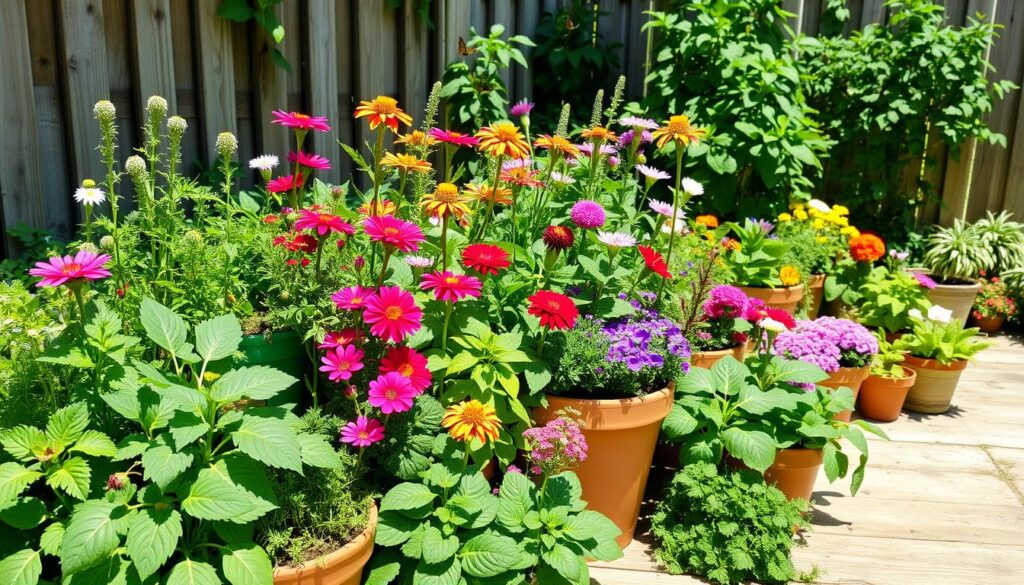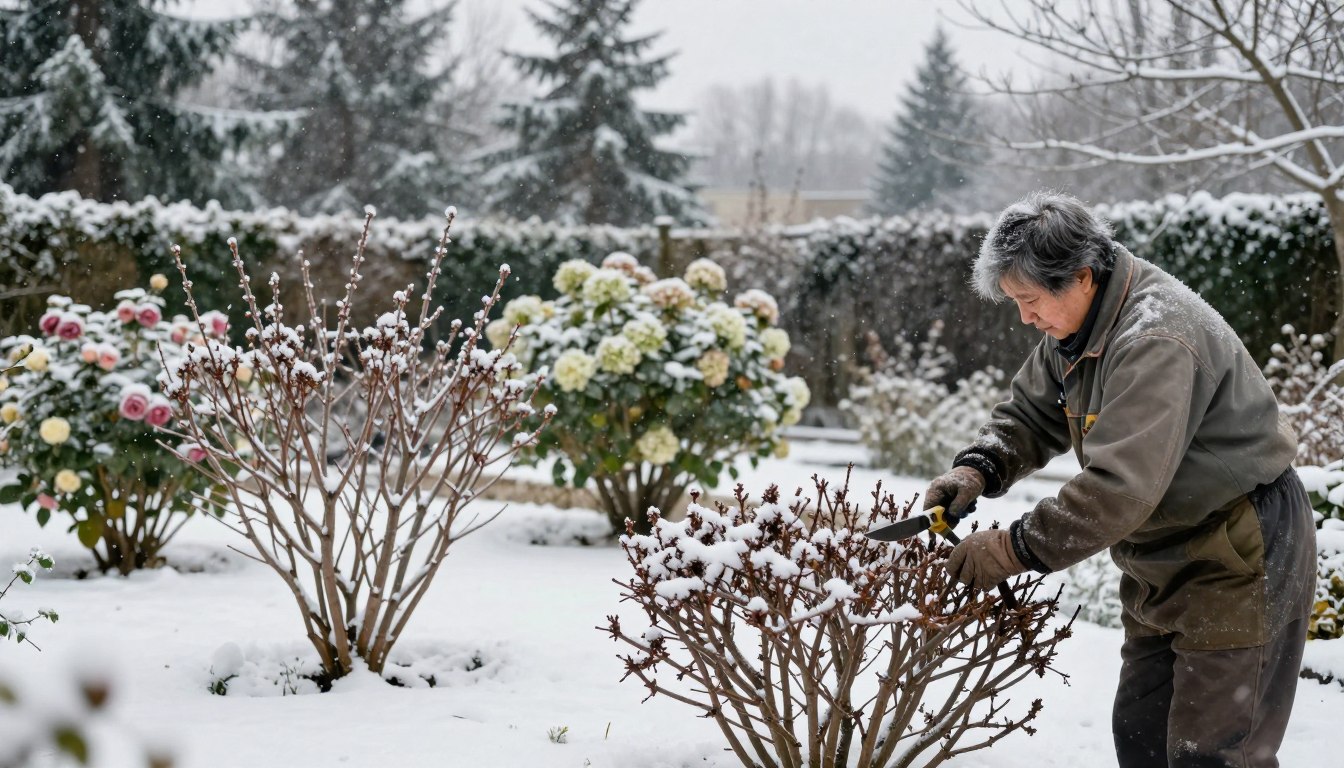Discover the joy of container gardening! It’s perfect for those with little outdoor space, like a patio, balcony, or a small home corner. Container gardening is ideal for city folks, apartment dwellers, and anyone into small-space gardening. With the right methods, you can grow flowers, veggies, and herbs in tight spots.
Container gardening is all about flexibility. Turn a patio, balcony, or windowsill into a lush oasis. Enjoy fresh produce and the joy of growing your own plants. You can grow everything from cascading flowers to bushy herbs and space-saving veggies.
Key Takeaways
- Container gardening is great for those with little outdoor space, like city folks, apartment residents, or small patio owners.
- You can grow many plants in containers, including flowers, veggies, and herbs. This lets you enjoy a garden in small spaces.
- Container gardening lets you create a personalized, thriving garden, no matter the size of your outdoor area.
- With the right techniques, like proper watering and fertilizing, you can have a lush, productive container garden. It brings joy and fresh produce right to your doorstep.
- Embracing container gardening lets you grow your own food and enjoy the calming experience of plant care, even in small spaces.
Choosing the Right Containers
Choosing the right size and material for your containers is key to successful container gardening. For most vegetables, a container at least 12 inches wide or the size of a 5-gallon bucket works well. You can pick from plastic, terracotta, metal, ceramic, or fabric grow bags, each with its own benefits.
Terra Cotta Pots for Drier Environments
Terra cotta pots are a classic choice for gardeners. They’re perfect for plants that like dry soil, thanks to their porous nature. But, they can be heavy and might break if it gets too cold.
Glazed Pottery for Moisture Retention
Glazed ceramic pots are durable and come in many colors. They also keep moisture in better than terra cotta. But, they can be pricier and harder to move.
Recycled Containers: Safe and Eco-Friendly
Using recycled containers is a great way to garden sustainably. Just make sure they’re safe for your plants. Don’t use containers that held detergents or chemicals before. Clean them well before planting. Items like large plastic buckets or wooden crates work well for small gardens.
Choosing the right container means making sure it drains well and has enough potting mix for your plants. With the perfect container, you can grow beautiful gardens in even the smallest spaces.
| Container Size | Suitable Vegetables |
|---|---|
| 24-inch diameter pot | Large pepper, summer squash, indeterminate tomato and cage, cucumber, artichoke, and combinations of vegetables and herbs |
| 18-inch diameter pot | Broccoli, cauliflower, large cabbage, small eggplant, all greens in multiples, small pepper, and determinate tomato and support |
| 14-inch diameter pot | Any herbs, cabbage, collards, spinach (3 to 4), non-heading lettuce (3 to 4), and arugula (3) |
| 10-inch diameter pot | Small herbs, strawberry, and lettuce |
Planning Your Container Garden
Container gardening is a great way to live sustainably and enjoy indoor plants. You can pick compact edibles, tasty herbs, and plants that save space. This way, you can make a beautiful green thumb spot on your windowsill or patio.
Compact Edibles for Small Spaces
Now, you can find edible plants that stay small, ideal for miniature gardens and portable gardens. Think about patio raspberries, zucchini, strawberries, and bush cucumbers for containers. They do well and are simple to keep up.
Also, compact tomatoes, lettuce, and peppers are great choices. They grow well in containers and are easy to care for.
Herbs: Easy to Grow and Flavorful
Herbs are perfect for container gardening. They’re easy to look after and add great flavor to your food, desserts, and drinks. Perennial herbs like chives, oregano, thyme, rosemary, and sage come back every year. They’re a smart pick for your herb garden.
Climbing Plants: Vertical Gardening
Use a climbing plant like pole beans or peas to make the most of your space. Just hang a low-cost trellis in your container, and let the vines grow. This creates a beautiful and efficient vertical gardening look.

“Container gardening is a game-changer for those with limited space. By thoughtfully selecting compact, easy-to-grow options, you can enjoy a thriving indoor plants oasis right at home.”
Container Gardening Tips
Gardening in containers is great for those with little outdoor space. You can grow herbs, veggies, or flowers. It’s important to take good care of your plants in grow bags, planters, and indoor plants for them to do well.
Proper Watering and Fertilizing
Containers can get dry fast, especially in the summer. To keep your plants healthy, water them every day. If it’s really hot, you might need to water them twice a day.
It’s also key to use the right soil mix for good drainage and moisture. Feed your plants with an organic fertilizer every 2-3 weeks. Fish emulsion is a good choice to give them the nutrients they need.
Maximizing Space with Vertical Gardening
When you’re gardening in a small space, every bit of space matters. Use vertical gardening to make the most of what you have. Hang plants on railings or fences to save ground space and make your garden look great.
This way, you can grow vining vegetables and climbing plants. It’s a smart way to use your space and make your potted plants and herb garden look beautiful.
| Container Size | Recommended Depth | Suitable Plants |
|---|---|---|
| 6″-9″ | Shallow-rooted vegetables (e.g., chives, lettuce) | |
| 12″-18″ | Moderate-depth vegetables (e.g., peppers, broccoli) | |
| 18″-24″ | Deep-rooted vegetables (e.g., tomatoes, potatoes) |
With the right container gardening tips and care, you can have a beautiful edible landscaping and sustainable living space, even in a small area. Show off your green thumb and watch your herb garden grow!

Making Your Own Soil Mix
Gardening in containers is a great way to save space and money. It lets you grow many plants, like herbs, veggies, flowers, and shrubs. Making your own soil mix is a smart move, especially in small spaces, to cut costs.
For a top-notch soil mix, mix equal parts of homemade compost, peat moss, and perlite or vermiculite. This blend ensures good drainage and keeps nutrients in place. Making your own mix not only saves money but also gives your plants the best environment to grow.
Buying a pre-made potting mix can be pricey. It’s because of the ingredients, packaging, and shipping. But, making your own mix lets you tailor it to your plants’ needs. This is great for herbs, edible landscaping, or small-space gardening with potted plants.
- Common ingredients in potting mix include sand, compost, worm castings, pine bark, sphagnum moss (or peat moss), coir, perlite, and vermiculite.
- A basic recipe is 1 part peat moss, 1 part perlite, and 2 parts compost.
- For starting seeds, use 2 parts compost, 2 parts peat moss, and 1 part perlite or vermiculite.
By making your own mix, you ensure your plants get the best nutrients and conditions. This is true whether you’re into hydroponics, planters, or grow bags for your garden.

Creating your own soil mix is easy and can save you money. With a few simple ingredients and some time, you can make the perfect soil for your containers. This way, you’ll enjoy a great harvest.
Conclusion
Container gardening is great for both new and experienced gardeners. It lets you grow a garden even in small spaces. It’s perfect for city folks and those with little time.
This guide has given you the best tips for a beautiful and productive container garden. You’ve learned how to pick the right containers and plan your garden. You also know how to make your own soil mix and use vertical gardening to save space.
Starting a container garden brings more than just fresh produce. It’s good for your mind, lowers stress, and can be a fun way to exercise. So, dive into container gardening and enjoy the many benefits it brings. Watch your garden grow with herbs, fruits, or flowers.
FAQ
Q: What are the benefits of container gardening?
A: Container gardening is great for small spaces, like apartments or balconies. You can grow a wide variety of plants in containers. It’s perfect for those with limited space who want to grow their own food.
Q: What are the best container materials to use?
A: You can choose from plastic, terracotta, metal, ceramic, and fabric grow bags for containers. Each material has its own advantages and disadvantages. Terra cotta is good for plants that like dry conditions. Glazed pottery keeps moisture in but can be heavy.
Make sure to clean recycled containers well before using them. They should not have held detergents or chemicals before.
Q: What types of plants grow well in containers?
A: Many plants are perfect for small spaces, like patio raspberries, zucchini, strawberries, and bush cucumbers. Compact tomatoes, lettuce, and peppers are also great for containers. Herbs like chives and oregano are easy to care for and add flavor to many dishes.
Perennials such as rosemary and sage come back every year. Consider using a trellis for climbing plants like pole beans or peas.
Q: How do I care for my container garden?
A: Good drainage is key for containers, as they dry out quickly. Water them every day, or twice a day in summer. Use an organic fertilizer every 2-3 weeks to feed your plants.
Adding compost to your soil mix helps with nutrients and microbes. This keeps your plants healthy and thriving.
Q: How can I maximize my container gardening space?
A: Use vertical gardening to make the most of your space. Attach vines to railings or fences, or build trellises with bamboo or metal posts. This way, you can grow more plants in less space.
Q: How can I make my own soil mix for container gardening?
A: Mix equal parts homemade compost, peat moss, and perlite or vermiculite for a great soil mix. This blend ensures good drainage and nutrient retention. Making your own soil mix saves money and supports your plants’ health.






